Updated (08/30/2023): Includes additional information about a Japanese puppet government coin recently added to my collection.
How did they teach you to be just a happy puppet dancing on a string?
How did you learn everything that comes along with slavish funnery?
Tell me something, if the world is so insane
Is it making you sane again to let another man tug at the thread that pulls up your nodding head?
“You Happy Puppet,” 10,000 Maniacs
I recently purchased some coins that had been issued by World War II-era puppet governments. I find these coins to be fascinating in a number of respects. For one thing, it’s always interesting to possess a coin that has outlived the government that issued it. Additionally, these coins illustrate many important themes, and are an indelible part of the overall history of World War II.
When Japan invaded Manchuria in 1931, kicking off the Sino-Japanese portion of World War II, it wasn’t hard to see why Japan would want the strategically important region. Manchuria (home of the Qing Dynasty, which had ruled over China for centuries until the start of the Republic Era in 1911), was rich in natural resources and, with memories of the Russo-Japanese War still fresh in everyone’s minds, it provided Japan with an important buffer against its old foe. And, of course, assuming Japan wouldn’t just be satisfied with one part of China, Manchuria would be a good starting point for additional invasions.
With China either recovering from or in the midst of various internal conflicts, including one with the Communists that would eventually reach its conclusion in 1949, it wasn’t able to put forth much opposition to advancing Japanese troops. Within a few months, Japan had overrun Manchuria, and by early 1932, Japan had established the independent republic of Manchukuo (“Great Manchu Nation”).
Of course, Manchukuo was independent in name only. In reality, the republic was actually a puppet state for Japan (for instance, the commanding officer of the Kwantung Army in Manchukuo had the power to veto the decisions of the purportedly independent republic’s government). And nowhere was this more apparent than in 1934, when Japan decided to change Manchukuo from a republic into a monarchy. The last emperor of China and head of the Manchu-based Qing Dynasty, Puyi, who had been installed as “chief executive” in 1932, was crowned ruler of Manchukuo, but his authority was subordinate to Kwantung Army.
Japan has its reasons for establishing a puppet government instead of simply annexing and occupying Manchuria. For one thing, Japan hoped to gain international recognition of Manchukuo. While the League of Nations and the U.S. condemned the Japanese invasion, other nations, including Costa Rica, the Dominican Republic, Hungary, Spain, and future Axis co-members Germany and Italy recognized Manchukuo as an independent nation.
But mostly, Japan hoped to use Manchukuo’s natural resources and strategic location to conquer the rest of China. With Japan getting most of the good stuff, Manchukuo had to make due with whatever was left. As such, the coins of Manchukuo tended to be made of cheaper, more affordable metals like zinc, aluminum, copper-nickel, or bronze. Perhaps the most distinctive Manchukuo coins are the ones made from red fiber magnesite, an abundant raw material in the region.
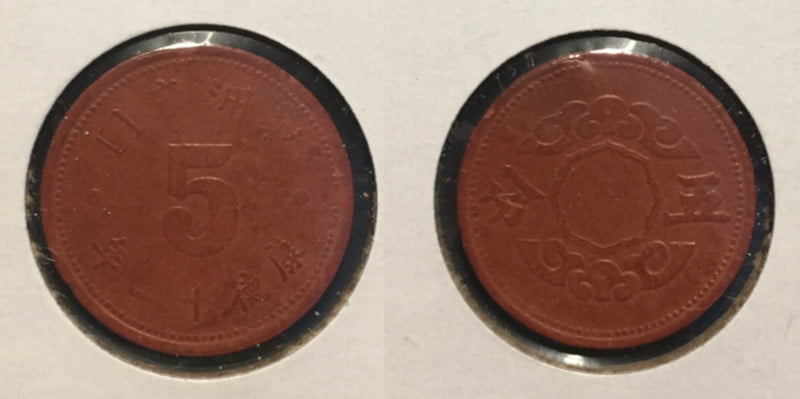
If you’re going to buy one of these red fiber coins online, then be prepared to gamble. Most uncertified red fiber coins are very affordable – however, the bulk come from China. As a rule, you should generally avoid buying coins from there – unless you don’t care about authenticity. Or if you just want one for your collection and don’t want to pay for a certified red fiber coins, which can be quite pricey. I saw one certified 5 fen coin go for $200-plus on eBay. Ultimately, I got this one from a dealer in the Czech Republic with good reviews and a liberal return policy. It didn’t cost me that much, and I really like it. So if it turns out to be fake – oh well.
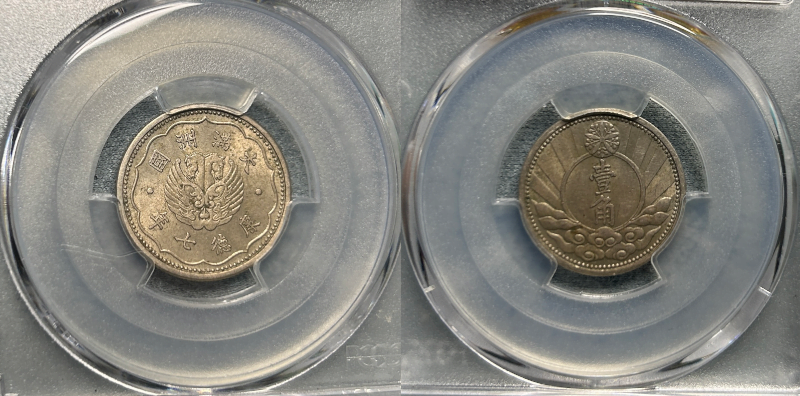
Luckily for me, this certified copper nickel 10 fen coin was fairly affordable. It’s a nice looking coin that boasts what appears to be a dragon head on the obverse but, on closer inspection, is actually two winged horses. On the reverse, there’s a subtle bit symbolism as the Chinese spring orchid, which served as the national symbol of Manchukuo emperor Puyi, adorns the top, but behind it are sun rays resembling the Japanese war flag.
Japan set up several other puppet governments to rule various regions of China. One of the larger ones was the Reformed Government of the Republic of China, which ran from 1938-1940 and had jurisdiction over the provinces of Anhui, Jiansu, Zhejiang, as well as the major cities of Nanjing and Shanghai. The government then set up the Hua Hsing Bank to issue coins and notes.
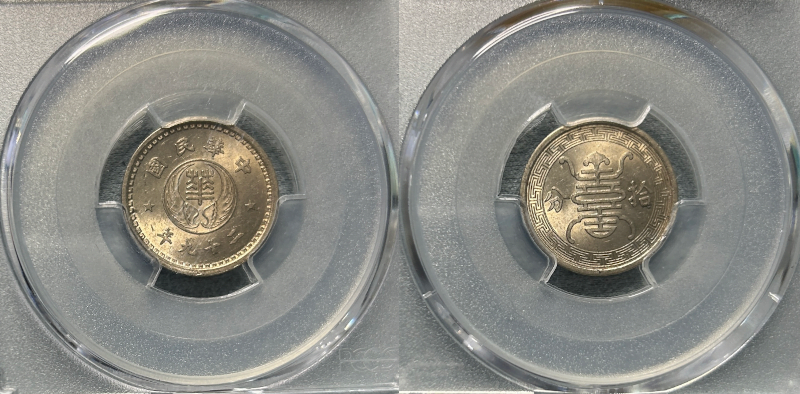
The above coin is a 10 fen piece that was one of several different denominations issued by the Hua Hsing Bank. The obverse of the coin has “Republic of China” written at the top and “Year 29” (1940) on the bottom. In the middle is a stylized version of the “Hua” character that’s surrounded by wings (maybe a phoenix rising from the ashes of the old Republic of China government?). The reverse has an image of a stylized character for “shou,” which means “long life.” Seems ironic, considering there was a war going on, but I’m sure the bank and government intended on being around for a long time.
So of course, in 1940, the Reformed Government was merged with another puppet regime, the Provisional Government of the Republic of China, into the Reorganized National Government of the Republic of China under the control of former Kuomintang official Wang Jingwei. Of all the Chinese collaborationists, Wang was probably the most notorious due to his close ties to Sun Yat-sen and the important role he played in the 1911 Revolution. His decision to make a deal with the Japanese cast him as a traitor — China’s version of Vidkun Quisling or Benedict Arnold.
In fact, after he died in 1944 (sparing him from a war crimes/treason trial and execution), he was buried near Sun’s tomb as a means to preserve that link between the original Republican government and Wang’s puppet state. In 1946, with Chiang Kai-shek back in charge of things (for a few years, at least), he ordered Wang’s tomb to be bombed with explosives and his body burned. I guess it pays to be on the winning side…
When Nazi Germany defeated France in 1940, they utilized much of the same logic that the Japanese used in establishing their puppet governments. The Nazis overran France so easily and completely that the demoralized French were faced with some pretty humiliating options: Abandoning the country and establishing a government-in-exile in French North Africa in order to continue the war, uniting with the United Kingdom and fighting alongside their new countrymen, or surrendering to Germany and becoming part of the Greater German Reich.
France went for surrender and was forced to accept a division of its country, with the Nazis occupying three-fifths of France (including Paris). French Prime Minister Henri Philippe Petain moved his government to the spa town of Vichy and immediately set up a purportedly independent government to administer the remaining two-fifths of the country, as well as France’s vast overseas colonies.
Of course, Vichy was nothing more than a Nazi puppet government. Hitler wanted this arrangement so that Germany would be free from the financial and military burden of overseeing France’s empire. Additionally, Hitler let France keep its navy out of concern that forcing it to submit to the Kriegsmarine would drive French naval officers to turn their vessels over to the British.
Petain, meanwhile, set about creating The French State – an authoritarian regime designed to address what he saw as the flaws of the now-defunct Third Republic. Petain, a reactionary at heart, saw the Third Republic as decadent and liberal and wanted to go back to a more conservative, religious and family-oriented time. As such, he set up a police state, replaced the French Revolution-era national motto of liberté, égalité, fraternité with travail, famille, patrie (work, family, fatherland), and openly collaborated with the Nazis. Whatever independent authority he claimed to possess more or less disappeared after the Allies landed in North Africa in 1942, whereupon the Nazis gave up all pretenses and simply occupied the rest of France.
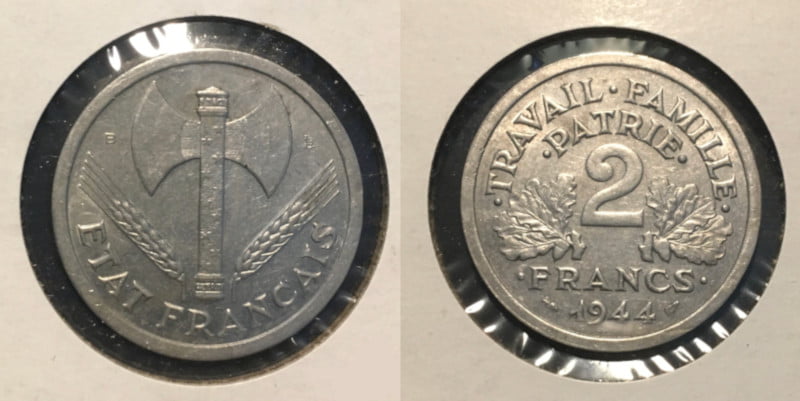
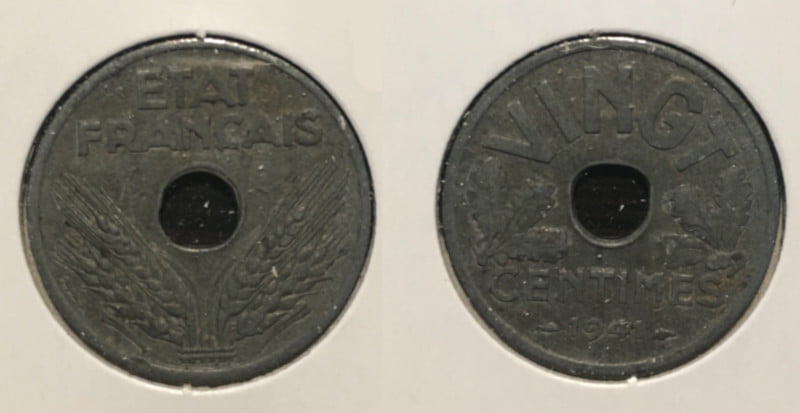
The above Vichy coins represent Petain’s values and the state he had created. The travail, famille, patrie motto is prominently emblazoned on the reverse of the 50 centimes, 1 franc and 2 franc coins, along with the official name of the Vichy regime (“Etat Francais” or “The French State”). The obverses of those three coins features a double-headed Frankish ax combined with a marshal’s baton – a reference to Petain, who held the honorary title of “Marshall of France.” The 20 centimes coin is the outlier, bearing a hole in the middle and not containing the ax or motto.
With one major exception, Vichy coins are very cheap and easily available online. For one thing, owing to wartime austerity measures (as well as to reflect Petain’s values of hard work and putting the country first), the materials used in Vichy coins tended to be cheap metals like zinc, aluminum or iron. Additionally, there is plenty of supply as hundreds of millions of coins were minted during the four years of Nazi domination. Demand, on the other hand, is debatable what with the long period of time after the war where France struggled to come to terms with the Vichy period.
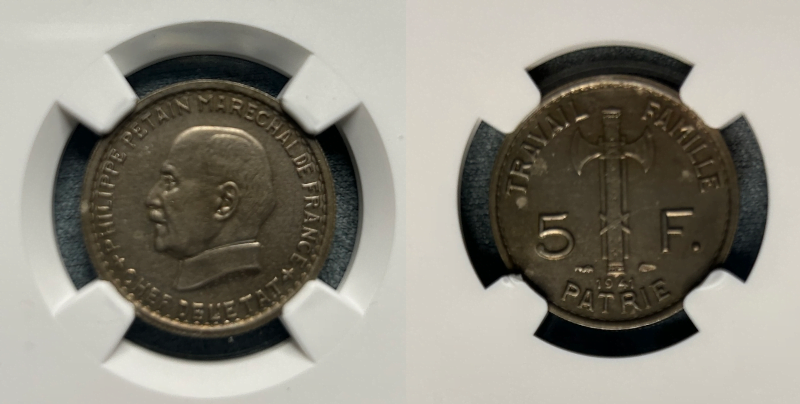
Indeed, there is really only one Vichy coin that is considered valuable (other than a host of pattern coins that were never officially approved for circulation). A 5 franc coin with Petain’s portrait on the obverse and the ax and national motto on the reverse was unveiled in 1941. The coin, which would be made of nickel and copper, was nixed by the Germans, who wanted those materials for the war effort. Some 13 million coins were on a ship destined for Germany to be melted down and re-used by the Nazis when it was sunk by the Allies. Approximately 50,000 coins were recovered, which makes them very valuable and collectible.
In the end, what struck me the most about these coins is that they draw interesting parallels between German and Japanese policies and fortunes during the war. Both experienced success during the early phases of the war (not surprising – considering they had been on war footing for years leading up to the start of World War II). Both had reasons for propping up puppet regimes in China and France (and, indeed, in plenty of other places in Europe and Asia, including Vietnam, the Philippines, Cambodia, and several parts of China for Japan and Croatia, Slovakia, Greece, Norway and Italy for Germany) rather than simply annexing their conquests.
And as the tide of the war turned on them both, Germany and Japan would abandon their puppets and retreat back to their own borders in a desperate fight to avoid total defeat. Of course, the after-effects of their quasi-occupations would reverberate for decades – long after the strings were officially cut.

